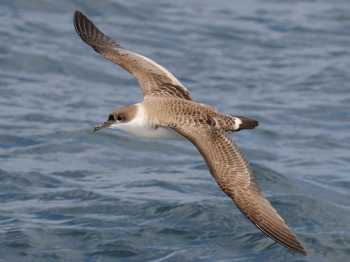Katherine Haman (Southeastern Cooperative Wildlife Disease Study, University of Georgia College of Veterinary Medicine, Athens, USA) and colleagues, writing in the Journal of Wildlife Diseases, have looked at strandings of Great Shearwaters Puffinus gravis on the Atlantic coast of the United States.
The paper’s abstract follows: “The Great Shearwater (Puffinus gravis) is an abundant pelagic seabird that undertakes transequatorial migrations between the North and South Atlantic Ocean. This species is a useful indicator of large-scale alterations in marine dynamics due to its wide geographic range, long-distance migrations, and relative abundance. From 1993 to 2011, 12 separate mortality events, with 4,961 Great Shearwaters recovered, were documented along the eastern coast of the United States. Of these, seven events (n=4,885) occurred in the Southeast (SE) and five (n=76) in the Northeast (NE) United States. The cause of death was determined either by necropsy (n=60) or external examination (n=4,901). All Great Shearwaters stranded along the SE United States were emaciated while 58% were emaciated in the NE United States. No plastic was observed in Great Shearwaters in the SE US (n=27), but the gastrointestinal tract of 82% (n=27) of all stranded birds along the NE United States had at least one plastic bead. There was no evidence of infectious disease or heavy metals in stranded Great Shearwaters examined (n=14, from the 2005 SE event). Stable isotope analysis of feathers (n=9, from a 2007 SE event) suggests dietary differences between emaciated stranded birds and live-caught healthy birds. The temporal distribution of stranding detections suggests a general increase in the number of observed Great Shearwa
ter strandings over the past two decades. From 1993 to 2000 there were a total of three mortality events with 296 individual Great Shearwaters. However, there was a threefold increase in the number of mortality events from 2001 to 2011 (nine events involving 4,665 individuals). The causes of this apparent increase in strandings are unknown but may be due to an increase in reporting effort over the past two decades combined with changing oceanographic conditions in the South Atlantic Ocean, leading to large-scale mortality of emaciated Great Shearwaters along the east coast of the United States.”

Great Shearwater. Photograph by John Graham
Reference:
Katherine H. Haman, K.H., Norton, T.M., Ronconi, R.A., Nemeth, N.M., .Thomas, A.C., Courchesne, S.J., Segars, A. & Keel, M.K.2013. Great Shearwater (Puffinus gravis) mortality events along the eastern coast of the United States. Journal of Wildlife Diseases 49: 235-245.
John Cooper, ACAP Information Officer, 20 May 2013

 English
English  Français
Français  Español
Español